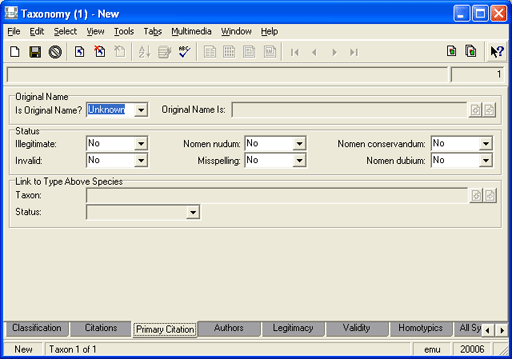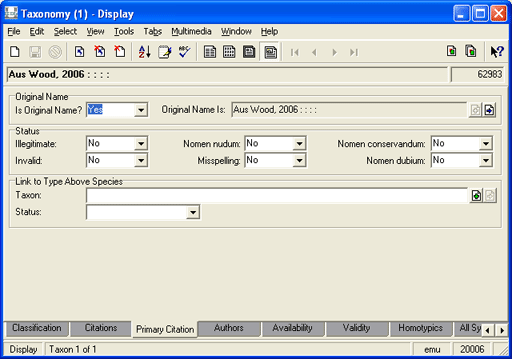The Primary Citation tab is useful for adding additional information about the status of the scientific name as it appears in the primary citation:

There are three groups of fields on the Primary Citation tab:
The combination (i.e. the genus and species epithets) by which a species was first described is known as its original name (ICZN) or basionym (ICBN).
If this name (as it is given in the Primary Citation![]() In Taxonomy, the paper / article that first proposes (specifies) the scientific name for a species. In Botany this paper is known as the Protologue.) is the original name for this species:
In Taxonomy, the paper / article that first proposes (specifies) the scientific name for a species. In Botany this paper is known as the Protologue.) is the original name for this species:
- Select Yes from the Is Original Name?: (Original Name) drop list.
When the record is saved the scientific name will display in the Original Name Is: (Original name) field (which is read-only):

If the name (as specified in the primary citation) represents a recombination (i.e. the same species epithet with a new genus):
- Select No from the Is Original Name?: (Original Name) drop list.
The Original Name Is field becomes available.
- Attach the original scientific name to the Original Name Is: (Original Name) field.
Note: The ICBN and ICZN codes specify how scientific names are affected when a name is not the original name. If this is the case, add further details on the Authors tab.
Six additional pieces of information describing the status of a name can be recorded here. These terms are not comprehensive and are used to capture only some of the information regarding the status of the name. Unfortunately some of these terms vary in meaning between the ICBN and the ICZN.
|
Term |
Description |
|---|---|
|
Illegitimate |
An ICBN specific term. A name is illegitimate when:
|
|
Invalid |
This term has different meanings depending upon which code is in use. For ICBN names, the name did not fulfill all relevant conditions deemed to apply under the ICBN at the time when it was published. For ICZN names, the name is either:
|
|
Nomen nudum |
The name has been published or mentioned without a proper and complete description. |
|
Misspelling |
The name has been incorrectly spelled. The term orthographic variant is also used. |
|
Nomen conservandum |
The name is (probably) illegitimate or invalid but has been given special status and has been retained for use under the plenary powers of the ICBN or ICZN. |
|
Nomen dubium |
A ICZN specific term. The name is of unknown or doubtful application. |
When a new species is proposed it is based on a Holotype![]() In Taxonomy the definitive Type specimen on which a scientific name of a species is based., a single specimen. This specimen is said to fix (or define) the name of the species.
In Taxonomy the definitive Type specimen on which a scientific name of a species is based., a single specimen. This specimen is said to fix (or define) the name of the species.
In the same way, in zoological nomenclature, a genus name is fixed (defined) by a particular species within the genus. And a family name is fixed by a particular genus within the family. The Link to Type Above Species fields are used to record this information.
If the lowest rank in the current taxonomic record is species, the Link to Type Above Species fields will be gr

If the lowest rank is genus, these fields will become available:

In the case of a genus taxon:
- Click the Attach
 button beside the Taxon field to attach to the type species.
button beside the Taxon field to attach to the type species. - Select the Status of the taxon from the Status drop list, e.g.:

